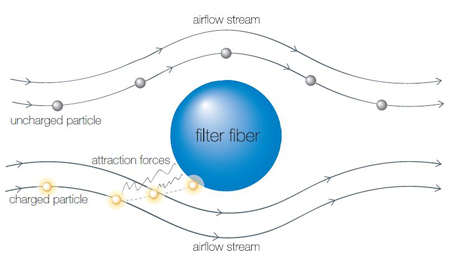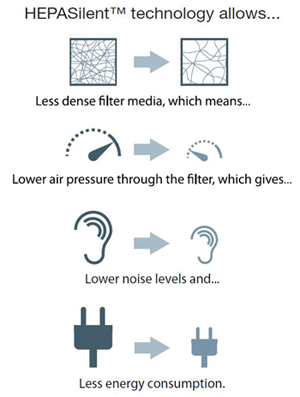
with HEPASilenttm Technology
Combining the Best in Electrostatic and Mechanical
Filtration Technology
Blueair's patented HEPASilenttm technology combines the best features of electrostatic and mechanical filter technology to enable the delivery of more clean air at a faster rate with less noise. Phenomenally low power usage minimizes energy consumption. Plus Blueair air purifiers actually reduce the levels of ozone in indoor air.
How it Works

- Air is drawn into the Blueair system via ultra-quiet fan.
- Airborne particles pass through an ion chamber and are electrically charged. This causes them to adhere effortlessly to the exclusive polypropylene filters.
- Charged particles are removed in the 3-Stage Progressive Filter. Stage 1 captures larger particles like pollen and dust. Stages 2 and 3 filter out even the smallest particles like cigarette smoke and exhaust. Together, the encapsulated ion chamber and 3-Stage Filtration Process combine to create Blueair's patented HEPASilenttm technology-delivering maximum airflow with minimum noise.
More Details
The HEPASilenttm particle filtration technology consists of two steps:
- Charging section for incoming particles.
- Trapping section for charged particles.
In the first step, an ionizer (a high voltage module) fills a chamber with negative ions. Incoming particles will then collide with the ions that will transmit their energy to the particles, giving the particles a negative electrostatic charge.
In the second stage, a gradient structured synthetic filter traps the charged particles. The filtration effect in the media is a combination of mechanical forces and electrostatic forces.
Bigger particles (<1 micron) are trapped mainly due to mechanical forces, while smaller particles (> micron) are mainly trapped with electrostatic forces.
A traditional filtration media is good at capturing big particles such as dust and pollen. Pollen are in the size of 10-100 micron and dust about 1-10 micron. These large particles are easily trapped by the filter media fibers like mosquitoes are trapped in a mosquito net and give a filtration efficiency of up to 100%. Smaller particle, less than 1 micron, penetrates the filter media because they are so small that they can follow the airflow around the filter fibers and get out on the back side of the filter. The result is a low filtration efficiency.

In the first step, the charging section, incoming particles enters the ionizer where they are negatively charged. The charged particles are then trapped in the second step, mechanical filtration, by the gradient structured filtration media while the clean air effortlessly go through the filter free from particles.
By giving the particles an electrostatic charge, the filtration efficiency for small particles increases. When the charged particles comes near a filter fiber, an attraction force emerge between the particles and the fiber, making the particles move towards the fiber and stick to its surface, instead of following the airflow stream around the fiber and through the filter

Uncharged particles follow the airflow stream pass the filter fiber while charged particles are forced from the airflow path by attraction forces
An example of the effect of the HEPASilenttm filtration system is shown below. When the electrostatic force is added to the mechanical filtration the filtration efficiency for smaller particles will increase. It is possible to use different combinations of charging sections and filter media to get desired filtration efficiency.

The mechanical filtration efficiency (red) increases with the particle size while the electrostatic (green) decreases and has higher effieciency in capturing small particles. A combination of both mechanical and electro-static filtration systems make a total efficiency of 99-100% of all particle sizes.
Benefits
Traditional HEPA filters have very high filtration efficiency but also very high airflow resistance. This makes it difficult to move air through the filter. A media with lower efficiency, where the fibers are not so densely packed, has lower airflow resistance and allows more air to pass the filter.
The HEPASilenttm technology allows Blueair to use less dense filter media and still achieve the same or even better efficiency than air purifiers using traditional HEPA filters. With high airflow combined with high efficiency, HEPASilenttm delivers more clean air and gives a better indoor air quality.
Additionally, the HEPASilenttm technology also generates lower noise and uses less energy since the fan doesn't need to work so hard to push the air through the filter.
The benefits of the Blueair HEPASilenttm technology can be summarized below:

The HEPASilenttm technology allows less dense filter media which gives lower air pressure, lower noise levels and less energy consumption.
Contact Information

|
||||||||||
|
